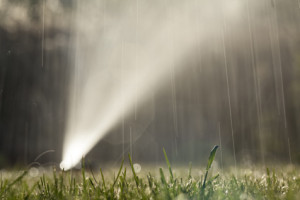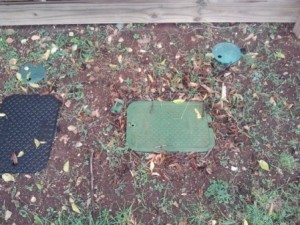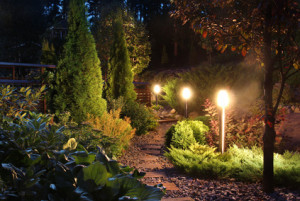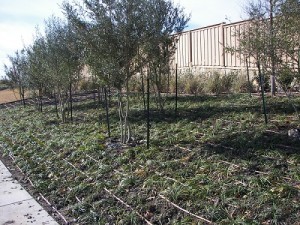Preparing Your Sprinkler System for Spring
Posted on March 21, 2015Finally, winter is over! Now is the time to start preparing your sprinkler system for spring. During the winter months, many homeowners turned their sprinkler systems off because most vegetation went into a dormant stage. March is the time when most people begin cleaning up their yards and getting their flower beds ready for spring planting. Before planting new vegetation, it is very important that the sprinkler system is turned on and any necessary repairs conducted before the plants go in the ground.
Because the McKinney sprinkler repair area has experienced several bouts of freezing temperatures during these past winter months, it is quite possible that sprinkler systems will not perform properly when turned back on. There could be broken pipes, malfunctioning valves, busted sprinkler heads, it’s all a surprise until it’s turned back on.
By turning on the sprinkler system before planting, you can avoid a situation where you will need to water everything by hand, or worse yet, the new plantings suffer from the drought. Also, you can avoid a situation where new plantings need to be dug up to repair sprinkler equipment either below or adjacent to the plants. This can be distressing to the vegetation as well as you!
You don’t necessarily need to have a professional conduct a system check; however, depending on what is discovered, you may wish to contact a Plano sprinkler repair company to conduct any of the repairs that are outside of your comfort zone.
The System Check
- You can do a simple check of your sprinkler system by turning on a single station at a time. It is a good idea to check your sprinkler system on a monthly basis.
- The majority of newer controller models have a test function that you can use to check the sprinkler system. Most are preset to run for two minutes per station.
- Simply walk through your property as each station runs and look for geysers or low pressure areas.
- If there is a station that has very low pressure and the spray heads are not popping up completely, this could mean that there is a leak. The leak is robbing the pressure to properly run the station.
- When checking stations such as flower beds, it is important to check the shrub risers against the house to make sure that the risers are not misaligned and spraying water onto the wall or window frames.
- There are literally hundreds of connections on a lawn sprinkler system that can spring a leak at anytime.
- Keep in mind that there are irrigation supply lines running throughout the yard, typically in the front yard and back yard. These lines can leak even with the controller turned off.
- A main line leak can usually be found by walking around the house and looking for any soggy spots.
New Year Maintenance Tips for Your Sprinkler System
Posted on January 23, 2015 The holiday season has come and gone and now it’s the start of a new year. It’s the time of year that we think about what’s to come and things that will need to get done. Although not much has changed with regards to your Plano sprinkler system over the past couple of months, it’s always a good idea to include your sprinkler system in your thoughts of the New Year. To help you guide that thought process, below are some items to think about and consider.
The holiday season has come and gone and now it’s the start of a new year. It’s the time of year that we think about what’s to come and things that will need to get done. Although not much has changed with regards to your Plano sprinkler system over the past couple of months, it’s always a good idea to include your sprinkler system in your thoughts of the New Year. To help you guide that thought process, below are some items to think about and consider.
1. Keep an eye on the weather. Although we will be getting out of the freezing temperatures hopefully soon, it is still cold out there overnight. Keeping an eye on the weather and forecast will help to prevent any frozen and broken surprises when you wake up in the morning. This will also hopefully help to steer clear of the need for emergency McKinney sprinkler repair.
2. Check your system after taking holiday decorations down. If you used decorations with stakes that needed to go into the ground, check to see if any accidentally punctured a sprinkler system line. Were your decorations on bushes or in flowerbeds? Check to see that your shrub risers haven’t become misaligned and are now spraying on the house and windows. If you had lights on your roofline, check to make sure that your rain and freeze sensor hasn’t become damaged or moved.
3. Start thinking about your spring plans. Want to revamp your yard or do something a little different in your flowerbed? Now is a good time to start considering what your options are and what your budget will be. This will give you the time to draft ideas and talk with your Plano sprinkler professional before springtime rolls around.
4. Schedule a system check. Now is a good time to schedule a system check to discover and tackle any big issues. Many people wait until the springtime to go through everything. By that time many McKinney sprinkler repair companies are pretty booked up and if you have new plants in the ground, waiting for an appointment may be rather frustrating. Beat the rush and take care of that at the beginning of the year. Then you’re ready for spring planting.
5. Check your rain and freeze sensor. Check to make sure that your rain and freeze sensor is free of debris (there may still be some leaves up there in that gutter). Spray your rain and freeze sensor with water on the sensor pad. Making it wet will mimic a rainfall. A red light should come on your controller indicating that the system will not water. This means that it is working and will help to protect from dangerous icy conditions and also from wasting water.
6. Check your system after a freeze. Prolonged freezing temperatures have the potential to cause the water in the pipes to freeze, cracking the pipes and creating leaks; however, the soil generally acts as an insulator. Run your system through the test cycle after a prolonged freeze. Catching a leak or other damage early on can help to save water, money and avoid future icy conditions.
What is Backflow, Backflow Prevention and Plano Sprinkler Repair?
Posted on December 18, 2014 In our north Texas service area, water for residential sprinkler systems is supplied by the city’s potable water (drinking water) supply lines. The sprinkler system is connected to the main water line on the customer’s side of the water meter. Typically the water meter is located in the parkway, between the sidewalk and the curb. It has a black circular lid that is flush with the surface of the ground and the meter itself is located below the ground. At least three feet away from the water meter (a distance required by most cities) is a backflow prevention device which connects the sprinkler system to the main water line. This is also located below the ground and it has a rectangular green lid.
In our north Texas service area, water for residential sprinkler systems is supplied by the city’s potable water (drinking water) supply lines. The sprinkler system is connected to the main water line on the customer’s side of the water meter. Typically the water meter is located in the parkway, between the sidewalk and the curb. It has a black circular lid that is flush with the surface of the ground and the meter itself is located below the ground. At least three feet away from the water meter (a distance required by most cities) is a backflow prevention device which connects the sprinkler system to the main water line. This is also located below the ground and it has a rectangular green lid.
A backflow prevention device prevents the flow of water from the sprinkler system back into the city’s water supply – backflow. Backflow is the unwanted reverse of water flow (or other liquids) into the drinking water supply. Once water leaves the city’s water supply and enters the sprinkler system, it is no longer classified as drinking water. Fertilizers, chemicals, bacteria, debris, etc. can enter into the residential sprinkler system water through spray heads or a broken pipe. This polluted water has the possibility of being introduced back into the drinking water supply, creating a very dangerous situation. This can happen in one of two ways: backsiphonage or backpressure. Backsiphonage is caused when the pressure on the supply side drops due to an event, such as a break in the city main, it can cause water to be sucked back into the drinking water supply. The fire department can also cause this to happen by pumping large volumes of water. Backpressure occurs when the pressure in the sprinkler system becomes greater than the supply side. Gravity or a pump can cause this type of situation.
In order to protect against backflow from the residential sprinkler system into the city’s drinking water supply, cities require that all sprinkler systems are equipped with a backflow prevention device. There are four typical types of backflow prevention devices, all of which are mechanical devices with physically block the water from the sprinkler system from entering back into the drinking water supply. The most common of the four for use on residential sprinkler systems is called a double check assembly. The others are called atmospheric vacuum breaker, pressure vacuum breaker and reduced pressure principle device. A backflow prevention device is required to be permitted by the city and the city requires that it is tested by a state-licensed Backflow Prevention Assembly Tester prior to being put into use.
The double check assembly (some homeowners may refer to it as a control valve), has two spring-loaded check valve assemblies to protect against backflow. It also has two shut-off valves, one on either side of the check valves. It is important to know where this device is located as this is how a homeowner would turn off their sprinkler system if there were an emergency and the system will not turn off at the controller. It is common for the lid covering the double check to become overgrown with grass. If this is the case, simply use a shovel or screwdriver to poke around in the vicinity of the water meter to find the lid. To help with the search, compare where the water meter and double check is located on neighbors’ properties. Most often they’re all set up in the same way.
When it comes to sprinkler repair, if a component of a double check assembly is broken, it is typically the handles of the shut-off valves. As with anything metal in the ground, it will rust. And the older it is, the rustier it will get. If the handles are rusty or they are very difficult to turn, do not turn them. Shut-off valves can freeze open, or worse yet freeze closed, never to be opened again. Call a Plano sprinkler repair company or a McKinney sprinkler repair company to have the double check closed to stop water flow. Replacing a double check assembly is typically more practical that repairing one; however, it is a very costly repair. It is significantly cheaper, faster and easier to install a polyvinyl chloride (PVC) ball valve down from the double check to turn the water supply on and off. This will never rust and is easy to use.
Holiday Landscape Lighting
Posted on October 27, 2014
Illuminated home garden path patio lights and plants in evening dusk
I was out running some errands the other day (mid- to late October) and I couldn’t believe my eyes when I saw Christmas decorations starting to be put out on shelves and racks! Halloween hasn’t even come and gone, and several big-box retailers are already revving up for the holiday season. Most people love decorating the inside of their homes for the holiday season, although there aren’t nearly as many that decorate the outside. Whether you’re getting ready to entertain family and friends and want your outdoors to be safe, or you want to add a bit of holiday color or maybe a temporary solution for either, there are options for you.
Home owners like to add landscape lighting during this time of year for different reasons. It gets dark very early this time of year resulting in guests arriving at your home when it is dark – don’t forget daylight savings time is right around the corner (Sunday, November 2nd). This can hide many safety hazards such as steps, drop offs, unlevel stones on pathways, vegetation, outdoor ornaments, etc. There are many different lighting options available to illuminate these hazards to prevent unnecessary injuries.
On the flip side of that coin is mood lighting for the holiday season. Many people like to entertain outside but have poor lighting in areas such as barbeque grills, outdoor kitchen area, gazebos, patios, etc. When using low voltage landscape lighting, it is possible to illuminate only the areas that you want visible without having too much light from a typical patio light. There are also colored lenses available if you have existing landscape lighting and simply want to add holiday color to your landscape.
In addition, many people like to display decorations during the holiday season. There are simpler and temporary ways such as outdoor flood lights with ground stakes that can simply be placed in front of the desired areas. With the low energy options such as light-emitting diodes (LEDs) and fluorescents, it is possible to add many lights without causing and overload situation.
What is Drip Irrigation and How Does it Work?
Posted on October 3, 2014 Right now, many cities within our service area are in Winter Stage 3 watering restrictions. For most municipalities, that means watering either once a week or once every two weeks. Last summer, we were also in Stage 3, only allowed to water once a week. Lakes that supply our potable water (used for drinking, washing and watering) are drastically low, and it is quite possible that we will enter into Stage 4 watering this summer. Stage 4 is no watering at all!
Right now, many cities within our service area are in Winter Stage 3 watering restrictions. For most municipalities, that means watering either once a week or once every two weeks. Last summer, we were also in Stage 3, only allowed to water once a week. Lakes that supply our potable water (used for drinking, washing and watering) are drastically low, and it is quite possible that we will enter into Stage 4 watering this summer. Stage 4 is no watering at all!
However, there is another option – Drip Irrigation. When watering restrictions are in place, most cities will permit the use of drip irrigation when aboveground watering is not permitted. Example – the City of Plano allows the use of drip irrigation to water foundations and landscaping (including grass, shrubs and trees) for up to two hours any day. So when you can only water once a week with the sprinkler heads, or not at all, having drip irrigation will allow you to water more often, protecting your foundation and landscaping.
What is Drip Irrigation? Drip irrigation was first developed in the mid-1960s and it has been used in landscaping since the mid-1980s in North America. It has even been field tested at the Center for Irrigation Technology in Fresno, California since 1989. Basically, drip irrigation consists of a series of tubes with holes and emitters that allow the water to drip slowly to the roots of plants, either onto the soil surface or directly onto the root zone. Drip irrigation can be located on top of the soil, buried below a layer of mulch or buried four to eight inches below the surface.
Why switch to or add Drip Irrigation? By using drip irrigation, you can water your foundation and plants and flowers, almost unrestricted, during watering restrictions. No more worrying about new cracks in your foundation. No more worrying about whether or not your newly planted begonias will survive the harsh Texas summers. No more hassle with dragging the hose out in the early morning hours to hand water your landscaping. Cities allow the use of drip irrigation more often than aboveground spray heads because it uses less water and saves water too…which means you save money! When the water is applied directly to the soil, there is less evaporation and runoff and the water is applied more accurately.
How to add or convert to Drip Irrigation? Converting or adding drip irrigation is a bit more than laying down soaker hoses or attaching drip irrigation tubing to an existing station of your sprinkler system. Adding drip irrigation involves installing new valves and equipment, creating separate watering zones. Creating separate zones for drip irrigation will allow for a more precise and frequent watering schedule. Also, drip irrigation requires a different level of water pressure as well as a different volume of water. If it were on the same zone as pop-up spray heads, it would not function properly.
Drip irrigation will soon be the norm for watering foundations and landscaping. It is something that if done right the first time with the right materials and workmanship will operate correctly and last a long time. In the long run, it is worth hiring a professional to come to your house for an hour to go over your options for drip irrigation as well as educate you in how it would work best on your property to maximize the use of your water.